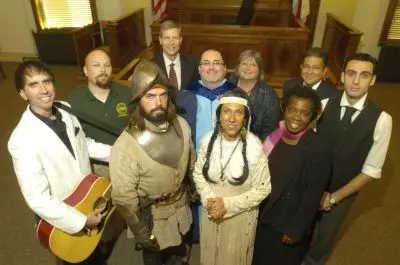Five hundred and one years ago, Juan Ponce de León set sail from Puerto Rico in search of undiscovered land, slaves, and gold. His fleet of three ships included the Santiago, the San Cristóbal, and the Santa María de la Consolación.
The ships reached the northern end of the Bahamas by March 27, 1513, which was Easter Sunday. Ponce and his crew sailed for another few days until they sighted land on April 2. Because it was the Easter season, which the Spanish called the “Festival of Flowers,” and because of the beautiful landscape, Ponce named the land he saw “La Florida”—the land of flowers. The next day, on April 3, 1513, Ponce came ashore to claim this land for Spain.
But where was he? Where, exactly, did Ponce come ashore? That is the question explored in the original courtroom drama “Ponce de León Landed HERE!!” The production can be seen online at myfloridahistory.org/ponce.
For centuries, scholars, historians, students, and others have been arguing about where, exactly, Ponce de León landed on Florida’s east coast in 1513, when he gave our state its name.
We know that Juan Ponce de León was born in Spain in 1474 to a noble family, where he became an experienced soldier. He joined Christopher Columbus on his second expedition to the New World in 1493. In 1504, Ponce successfully enslaved the native population of Hispaniola, and was named Governor.
A few years later, Ponce was named Governor of the neighboring island of Puerto Rico. It was from there that Ponce set sail for Florida. King Ferdinand II signed a contract with Ponce in 1512, granting him permission to search for “the islands of Benimy.” The contract included instructions for how Ponce was to distribute any gold and slaves that he acquired, and declared that he would be Governor for Life of any lands he discovered. Ponce assembled a crew of two hundred people that included women and free people of African descent, and sailed toward Florida.
Ponce’s first contact with the native population of Florida set in motion a process that would destroy the lives of people who had lived here for thousands of years. These people had developed sophisticated cultures that would not survive the continued European contact to follow.
When Ponce came to Florida, it changed the course of world history. Not only did he give this land the same name we use for it today, Ponce’s “discovery” of the Gulf Stream would lead to the first European colonization of what would become the United States, long before Jamestown was established and long before the Pilgrims landed at Plymouth Rock.
With the approach of the milestone 500th anniversary year of Ponce’s first voyage to Florida, residents of several areas along Florida’s east coast voiced enthusiastic claims that their town was where Ponce de León first made landfall when he gave our state its name in 1513. Each claimant could point to various interpretations of the available facts to support their position.
The Florida Historical Society staged the original courtroom drama “Ponce de León Landed HERE!!” to present the available information in an entertaining way. The performance that can be seen online was recorded at the Historic Volusia County Courthouse on January 12, 2013. An audience in Tallahassee watched the proceedings in DeLand “live” as they were projected on a screen at the Museum of Florida History.
In the production, actual lawyers and judges present different arguments supporting the St. Augustine area, Ponce Inlet, Melbourne Beach, and Jupiter Inlet as the most likely landing place of Ponce and his crew.
The jury hears testimony from early Florida archaeologist Clarence B. Moore, who laments that there is no physical evidence to support any of the claims. The Ais Queen testifies that she was there when Ponce came ashore, but cannot help us identify the spot where it happened because the landscape has been altered beyond her recognition. Then the jury hears from Ponce himself.
The claims about where, exactly, Ponce landed in 1513 are inconclusive and open to debate. Thanks to “Ponce de León Landed HERE!!” you can view the evidence and decide for yourself.
For more information watch the courtroom drama “Ponce de León Landed HERE!!” at myfloridahistory.org/ponce and read the book The Voyages of Ponce de León: Scholarly Perspectives by James Cusick and Sherry Johnson.
Dr. Ben Brotemarkle is executive director of the Florida Historical Society and host of the radio program “Florida Frontiers." The show can also be heard online at myfloridahistory.org.
